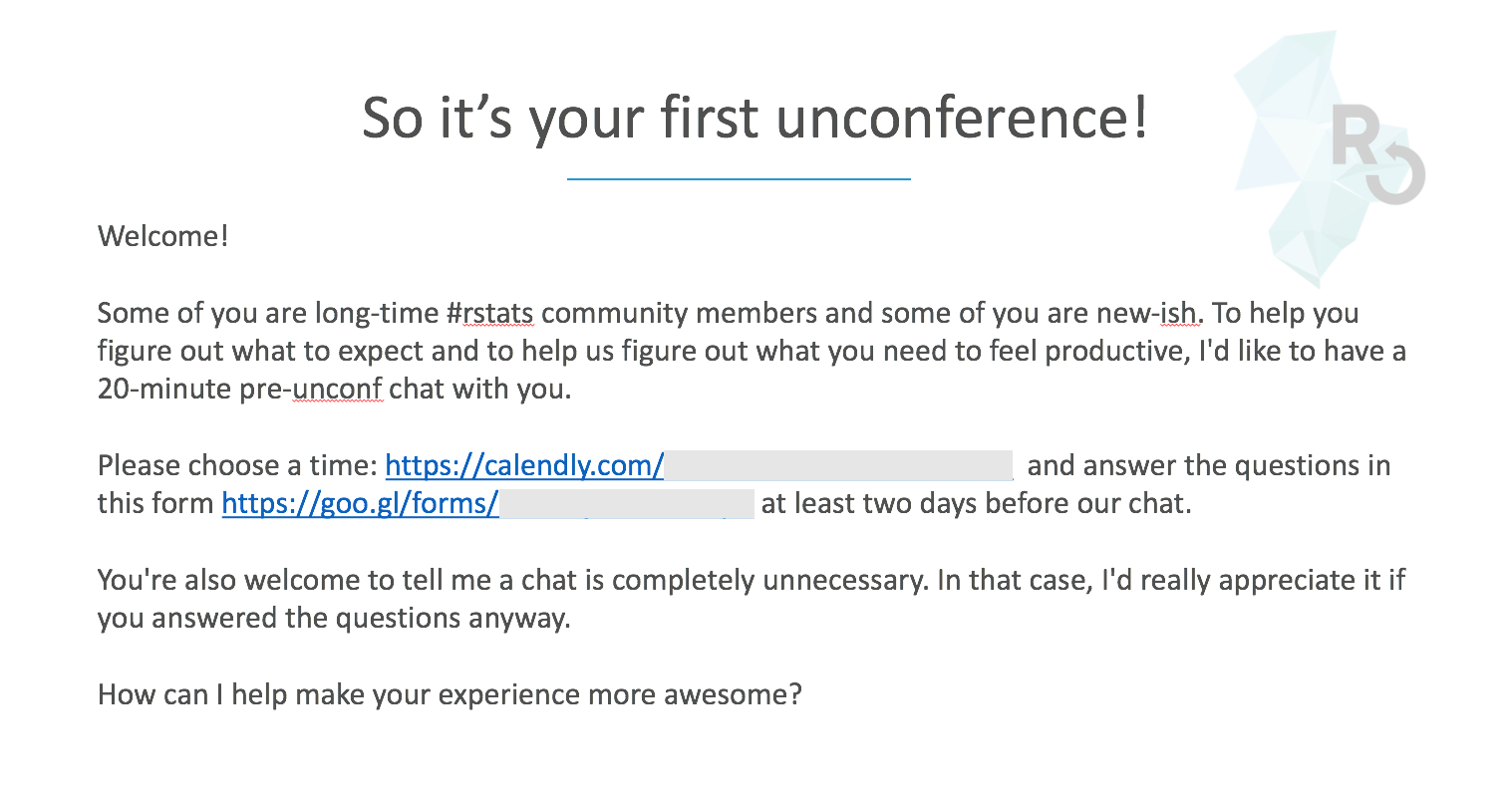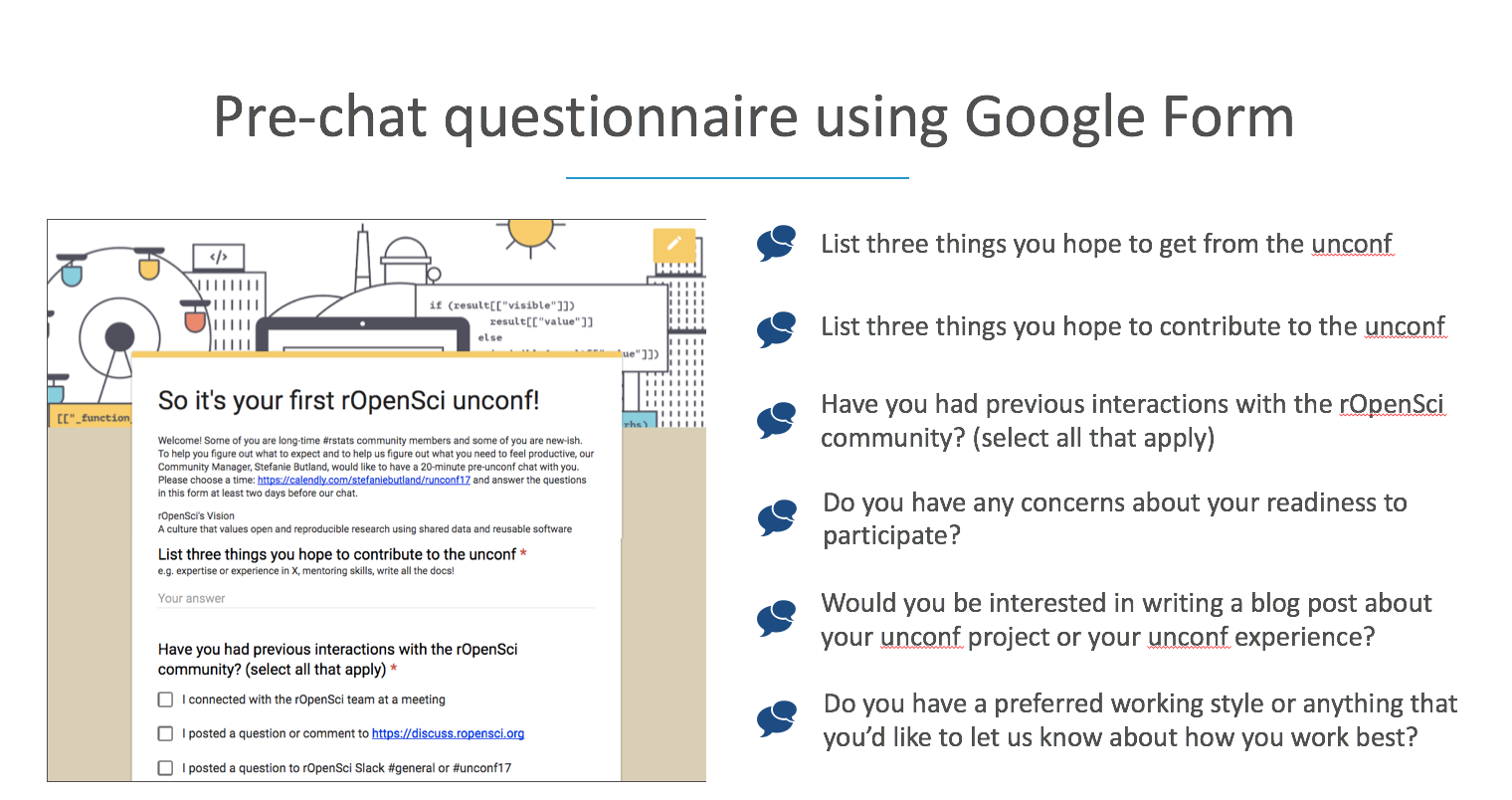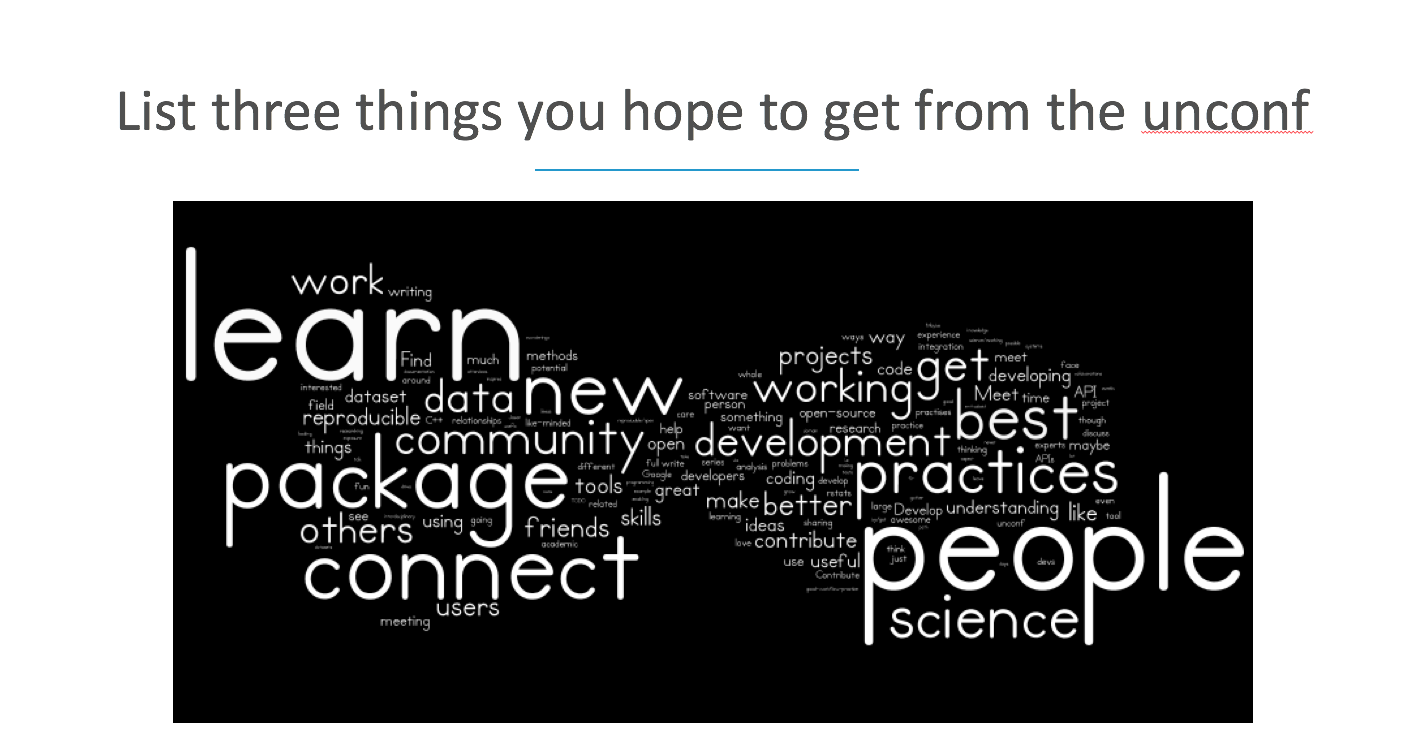Friday, December 1, 2017 From rOpenSci (https://ropensci.org/blog/2017/12/01/unconf-welcome/). Except where otherwise noted, content on this site is licensed under the CC-BY license.
This is cross-posted on Trellis blog.
I’m participating in the AAAS Community Engagement Fellows Program, funded by the Alfred P. Sloan Foundation. The inaugural cohort of Fellows comprises 17 community managers working in a wide range of scientific communities. This is cross-posted from the Trellis blog as part of a series of reflections the Fellows are sharing.
I’ve raved about the value of extending a personalized welcome to new community members and I recently shared six tips for running a successful hackathon-flavoured unconference. Building on these, I’d like to share the specific approach and (free!) tools I used to help prepare new rOpenSci community members to be productive at our unconference. My approach was inspired directly by my AAAS Community Engagement Fellowship Program (AAAS-CEFP) training. Specifically, 1) one mentor said that the most successful conference they ever ran involved having one-to-one meetings with all participants prior to the event, and 2) prior to our in-person AAAS-CEFP training, we completed an intake questionnaire that forced us to consider things like “what do you hope to get out of this” and “what do you hope to contribute”.
A challenge of this year’s unconference was the fact that we were inviting 70 people to participate. As a rule, one third of the crowd will have participated in one of our previous unconferences and two-thirds would be first-time participants. With only two days together, these people need to quickly self-sort into project groups and get working.
So I sent this email to 45 first-time participants:

Arranging meetings is one of my least favorite activities, but the free Calendly tool made this process relatively painless. When a person clicks on the calendar link in the email above, it reveals only times that I am available in my Google Calendar, the time slot they choose shows up in my calendar, and I receive a confirmation email indicating who booked a meeting with me. In my busiest week, I had 19 meetings, but that meant the bulk of them were done!
To make the meeting time most effective I followed AAAS-CEFP program director Lou Woodley’s model for onboarding our AAAS CEFP cohort by sending a set of questions to be answered in advance. I took the model to the next level by creating a free Google Form questionnaire so that all answers were automatically collected and could be viewed per individual or collectively, and automatically exported to a spreadsheet.

Questions included:
- List three things you hope to get from the unconference
- Examples: connect with people working in a similar domain, learn about best practices in data science with R, or develop a new package that does X
- List three things you hope to contribute to the unconference
- Examples: expertise or experience in X, mentoring skills, write all the docs!
- Have you had any previous interactions with the rOpenSci community?
- Examples: I read the rOpenSci blog, or I submitted software for rOpenSci open peer review
- Do you have any concerns about your readiness to participate?
- Examples: I’ve never developed an R package or How do I decide what project to work on?
Would you be interested in writing a blog post about your unconference project or your unconference experience?
Do you have a preferred working style or anything you would like to let us know about how you work best?
- Examples: I’m an introvert who likes to take my lunch alone sometimes to recover from group activities – it doesn’t mean I’m not having fun. or I know I have a tendency to dominate in group discussions – it’s totally fine to ask me to step back and let others contribute. I won’t be offended.
These questions encouraged participants to reflect in advance. The example answer snippets we provided gave them ideas from which to seed their answers and in some cases gave them permission to show some vulnerability. Individual’s answers gave me cues for things to address in our chat and freed both of us to spend our time talking about the most important issues.
The answers to the question “List three things you hope to get from the unconf” were so heartening:

Beautiful, but in a different way, were answers to the question, “Do you have any concerns about your readiness to participate?”. People expressed real concerns about impostor syndrome, their perceived ability to contribute “as much or as well” as others, and feeling “outclassed by all the geniuses present”. These responses prompted me to reassure people that they were 100% qualified to participate, and opened an opportunity to listen to and address specific concerns.
To conduct the pre-unconference chats, I used video conferencing via appear.in, a free, browser-based application that does not require plugins or user accounts. Rather than being exhausted from these calls, I felt energized and optimistic and I experienced many direct positive outcomes. These conversations enabled me to prime people to connect on day-one of the unconference with others with similar interests or from related work sectors. Frequently, I noticed that immediately after our conversation, first-time participants would join the online discussion of existing project ideas, or they themselves proposed new ideas. My conversations with two first-time participants led directly to their proposing community-focussed projects - a group discussion and a new blog series of interviews!
An unexpected benefit was that questions people asked me during the video chats led to actions I could take to improve the unconference. For example, when someone wanted to know what previous participants wished they knew beforehand, I asked for and shared example resources. One wise person asked me what my plan was for having project teams report out at the end of the unconference and this led directly to a streamlined plan (See Six tips for running a successful unconference).
Big thanks to AAAS CEFP training for giving me the confidence to try this community experiment! Arranging and carrying out these pre-unconference questionnaires and video chats took a big investment of my time and energy and yet, I consider this effort to be one of the biggest contributors to participants’ satisfaction with the unconference. Will 100% do this again!

